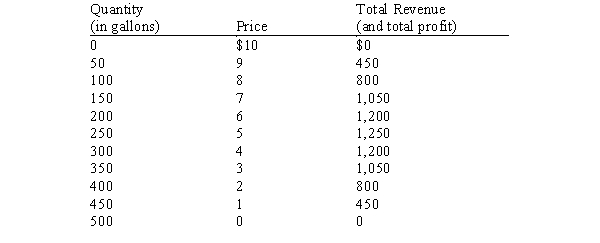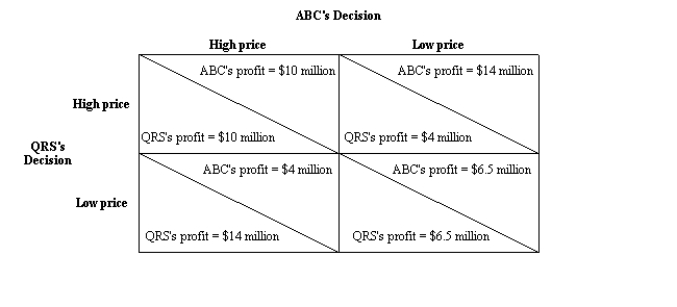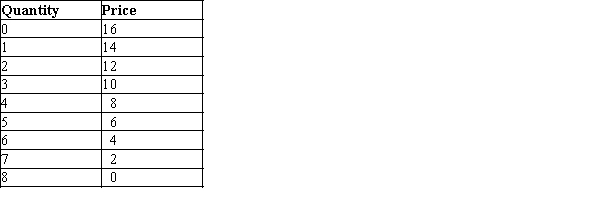A) one in which the players, pursuing their own interests, are likely to reach an outcome that is not particularly good for either player.
B) one in which an agreement between the players to behave in a certain way is not likely to hold up.
C) similar to the situation faced by Bonnie and Clyde in the prisoners' dilemma game.
D) All of the above are correct.
F) B) and D)
Correct Answer

verified
Correct Answer
verified
Multiple Choice
Game theory is important for understanding which of the following market types?
A) perfectly competitive and oligopolistic markets
B) perfectly competitive markets but not oligopolistic markets
C) oligoplistic but not perfectly competitive markets
D) neither oligopolistic nor perfectly competitive markets.
F) C) and D)
Correct Answer

verified
Correct Answer
verified
Multiple Choice
If a market is a duopoly and additional firms enter and do not cooperate, then
A) price and quantity fall.
B) price and quantity rise.
C) price falls and quantity rises.
D) price rises and quantity falls.
F) A) and C)
Correct Answer

verified
Correct Answer
verified
Multiple Choice
Table 17-29
Suppose that two firms, Wild Willy's Wonderdrink (Firm W) and Hyper Hank's Hydration (Firm H) , comprise the market for energy drinks. Each firm determines that it could lower its costs and increase its profits if both firms reduced their advertising budgets. But for the plan to work, each firm must agree to refrain from advertising. Each firm believes that advertising works by increasing the demand for the firm's energy drinks, but each firm also believes that if neither firm advertises, the cost savings will outweigh the lost sales. The table below lists each firm's individual profits:
Firm W
Breaks agreement Maintains agreement
and advertises and does not advertise  -Refer to Table 17-29. Which of the following statement(s) correctly characterizes the outcome of this game?
-Refer to Table 17-29. Which of the following statement(s) correctly characterizes the outcome of this game?
A) There is a Nash equilibrium when both firms advertise.
B) Both Firm W and Firm H have a dominant strategy to advertise.
C) Although both firms collectively would earn higher profits by maintaining the agreement not to advertise, self-interest will cause each firm to break the agreement.
D) All of the above are correct.
F) B) and C)
Correct Answer

verified
Correct Answer
verified
Multiple Choice
Which of the following is correct? When oligopolies collude
A) they make higher profits and consumers of the product are better off.
B) they make higher profits but consumers of the product are worse off.
C) they make lower profits and consumers of the product are better off.
D) they make lower profits and consumers of the product are worse off.
F) A) and C)
Correct Answer

verified
Correct Answer
verified
Multiple Choice
Table 17-13
Two home-improvement stores (Lopes and HomeMax) in a growing urban area are interested in expanding their market share. Both are interested in expanding the size of their store and parking lot to accommodate potential growth in their customer base. The following game depicts the strategic outcomes that result from the game. Increases in annual profits of the two home-improvement stores are shown in the table below.  -Refer to Table 17-13. Suppose the owners of Lopes and HomeMax meet for a friendly game of golf one afternoon and happen to discuss a strategy to optimize growth related profit. If they both agree to cooperate on a strategy that maximizes their joint profits, annual profit will grow by
-Refer to Table 17-13. Suppose the owners of Lopes and HomeMax meet for a friendly game of golf one afternoon and happen to discuss a strategy to optimize growth related profit. If they both agree to cooperate on a strategy that maximizes their joint profits, annual profit will grow by
A) $1.0 million for Lopes and by $1.5 million for HomeMax.
B) $0.4 million for Lopes and by $3.4 million for HomeMax.
C) $3.2 million for Lopes and by $0.6 million for HomeMax.
D) $2.0 million for Lopes and by $2.5 million for HomeMax.
F) B) and D)
Correct Answer

verified
Correct Answer
verified
Multiple Choice
Table 17-27
Each year the United States considers renewal of Most Favored Nation (MFN) trading status with Farland (a mythical nation) . Historically, legislators have made threats of not renewing MFN status because of human rights abuses in Farland. The non-renewal of MFN trading status is likely to involve some retaliatory measures by Farland. The payoff table below shows the potential economic gains associated with a game in which Farland may impose trade sanctions against U.S. firms and the United States may not renew MFN status with Farland. The table contains the dollar value of all trade-flow benefits to the United States and Farland.  -Refer to Table 17-27. This particular game
-Refer to Table 17-27. This particular game
A) features a dominant strategy for the U.S.
B) features a dominant strategy for Farland.
C) is a version of the prisoners' dilemma game.
D) All of the above are correct.
F) All of the above
Correct Answer

verified
Correct Answer
verified
Multiple Choice
Table 17-4
The table shows the town of Mauston's demand schedule for gasoline. For simplicity, assume the town's gasoline seller(s) incur no costs in selling gasoline.  -Refer to Table 17-4. Suppose there are exactly two sellers of gasoline in Mauston: Shellon and Standstop. If Shellon sells 150 gallons and Standstop sells 200 gallons, then
-Refer to Table 17-4. Suppose there are exactly two sellers of gasoline in Mauston: Shellon and Standstop. If Shellon sells 150 gallons and Standstop sells 200 gallons, then
A) Shellon's profit is $450 and Standstop's profit is $600.
B) Shellon's profit is $1,050 and Standstop's profit is $1,200.
C) the two firms are colluding and earn monopoly profits.
D) consumers in Mauston are worse off than they would be if the two firms colluded.
F) A) and C)
Correct Answer

verified
Correct Answer
verified
Multiple Choice
Figure 17-5. Two companies, ABC and QRS, are sellers in the same market. Each company decides whether to charge a high price or a low price. In the figure, the dollar amounts are payoffs and they represent annual profits for the two companies.  -Refer to Figure 17-5. In what sense is the game involving ABC and QRS similar to the prisoners' dilemma game involving Bonnie and Clyde?
-Refer to Figure 17-5. In what sense is the game involving ABC and QRS similar to the prisoners' dilemma game involving Bonnie and Clyde?
A) In both games, if the players pursue their own interests, then the outcome is the best possible outcome for each player.
B) In both games, a dominant strategy can be identified for each player.
C) In both games, cooperation between the players is easy to maintain.
D) All of the above are correct.
F) A) and C)
Correct Answer

verified
Correct Answer
verified
Multiple Choice
Table 17-4
The table shows the town of Mauston's demand schedule for gasoline. For simplicity, assume the town's gasoline seller(s) incur no costs in selling gasoline.  -Refer to Table 17-4. If there are exactly four sellers of gasoline in Mauston and if they collude, then which of the following outcomes is most likely?
-Refer to Table 17-4. If there are exactly four sellers of gasoline in Mauston and if they collude, then which of the following outcomes is most likely?
A) Each seller will sell 62.5 gallons and charge a price of $1.25.
B) Each seller will sell 62.5 gallons and charge a price of $5.
C) Each seller will sell 100 gallons and charge a price of $2.
D) Each seller will sell 250 gallons and charge a price of $0.
F) None of the above
Correct Answer

verified
Correct Answer
verified
True/False
If the output effect from increased production is larger than the price effect, then an oligopolist would increase production.
B) False
Correct Answer

verified
Correct Answer
verified
Multiple Choice
Table 17-37
Two restaurants with a focus on Mexican dining operate in Texama. Both Mitch's Mexican and Tim's Tacos need to decide whether to add Zesty Queso or Fresh Guacamole to their menus. The circumstances are that each firm wants to add only one of the two choices on their menu. Below you will find the profits for the stores, shown as: (1) the payoff to Mitch; (2) the payoff to Tim. 
-Refer to Table 17-37. Based upon the information from the table, you can conclude that this game is an example of
-Refer to Table 17-37. Based upon the information from the table, you can conclude that this game is an example of
A) a prisoner's dilemma.
B) price discrimination.
C) the game of chicken.
D) a natural monopoly.
F) None of the above
Correct Answer

verified
Correct Answer
verified
Multiple Choice
The Sherman Antitrust Act
A) overturned centuries-old views of English and American judges on agreements among competitors.
B) had the effect of discouraging private lawsuits against conspiring oligopolists.
C) strengthened the Clayton Act.
D) elevated agreements among conspiring oligopolists from an unenforceable contract to a criminal conspiracy.
F) A) and B)
Correct Answer

verified
Correct Answer
verified
Short Answer
Some people consider the NCAA (National Collegiate Athletic Association) to be a __________ in the market for college athletics.
Correct Answer

verified
Correct Answer
verified
Multiple Choice
Table 17-23
Two bottled beverage manufacturers (Firm A and Firm B) determine that they could lower their costs, and thus increase their profits, if they reduced their advertising budgets. But for the plan to work, each firm must agree to refrain from advertising. Each firm believes that advertising works by increasing the demand for the firm's product, but each firm also believes that if neither firm advertises, the costs savings will outweigh the lost sales. Listed in the table below are the individual profits for each firm.  -Refer to Table 17-23. At the Nash equilibrium, how much profit will Firm A earn?
-Refer to Table 17-23. At the Nash equilibrium, how much profit will Firm A earn?
A) $8,000 because firm A will maintain the agreement not to advertise, but firm B will break the agreement and choose to advertise.
B) $9,000 because each firm will break the agreement and choose to advertise.
C) $10,000 because each firm will maintain the agreement and choose not to advertise.
D) $11,000 because firm B will maintain the agreement not to advertise, but firm A will break the agreement and choose to advertise.
F) C) and D)
Correct Answer

verified
Correct Answer
verified
Multiple Choice
Figure 17-5. Two companies, ABC and QRS, are sellers in the same market. Each company decides whether to charge a high price or a low price. In the figure, the dollar amounts are payoffs and they represent annual profits for the two companies.  -Refer to Figure 17-5. If the two companies make their pricing decisions independently, then it is likely that ABC will
-Refer to Figure 17-5. If the two companies make their pricing decisions independently, then it is likely that ABC will
A) charge a high price only if QRS charges a high price.
B) charge a high price only if QRS charges a low price.
C) charge a high price regardless of whether QRS charges a high price or a low price.
D) None of the above are correct.
F) B) and D)
Correct Answer

verified
Correct Answer
verified
Multiple Choice
Predatory pricing refers to
A) a firm selling certain products together rather than separately.
B) a monopoly firm reducing its price in an attempt to maintain its monopoly.
C) firms colluding to set prices.
D) All of the above are examples of predatory pricing.
F) A) and C)
Correct Answer

verified
Correct Answer
verified
Multiple Choice
The Sherman Antitrust Act was passed in
A) 1836.
B) 1890.
C) 1914.
D) 1946.
F) A) and C)
Correct Answer

verified
Correct Answer
verified
Multiple Choice
Game theory is necessary to understand which kinds of markets?
A) monopoly
B) competitive
C) oligopoly
D) All of the above are correct.
F) B) and D)
Correct Answer

verified
Correct Answer
verified
Multiple Choice
Table 17-9
The table shows the demand schedule for a particular product.  -Refer to Table 17-9. If the marginal cost of production in this market is $4, what is the socially efficient quantity of output?
-Refer to Table 17-9. If the marginal cost of production in this market is $4, what is the socially efficient quantity of output?
A) 3 units
B) 4 units
C) 5 units
D) 6 units
F) All of the above
Correct Answer

verified
Correct Answer
verified
Showing 281 - 300 of 522
Related Exams